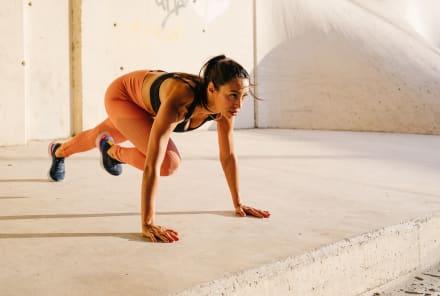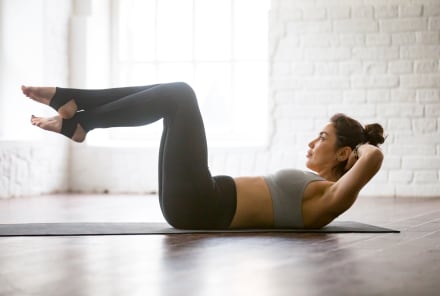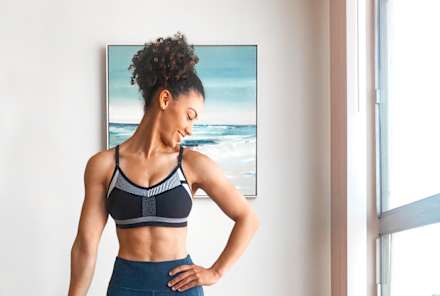Advertisement
Pilates vs. Yoga: What's the Difference & Which Workout Has More Benefits?


Quiz time: Do you consider yourself team Pilates or yoga? OK, you don't really need to choose sides, but it often seems like fitness fans fall into one category or the other. Yogis may gush over the mind, body, and soul trifecta experience of the practice, whereas Pilates aficionados swear by their intensely focused workout mode.
But the reality is, yoga and Pilates share many qualities and benefits. In fact, many people see these as complementary practices—and choose to do both yoga and Pilates for optimal mental and physical fitness.
Which raises the question: What's the real difference between Pilates and yoga? And why choose one, or both, as part of your well-being routine?
Pilates
While yoga's roots stretch back thousands of years, Pilates is relatively new. Joseph Pilates created this system in the 1920s as a way to rehabilitate bedridden soldiers during World War I. It has come a long way since then.
Today, there are two main forms of Pilates, reformer and mat. Both are low-impact and focus on building the core while strengthening the whole body. A reformer class uses a machine with spring resistance while most mat classes, as the name suggests, only require a mat to incorporate body-weight resistance.
The most common Pilates exercises, like hundreds and teasers, make appearances in both kinds of classes and work the abdominal muscles. These abs-centric moves are often used at the start of class so that students remember to engage their core throughout the session, even when the exercises focus on other body parts. "Nothing is worked in isolation, but with reference to the rest of the body," Pilates instructor and owner of Northants Pilates Karen Grinter says. "Joseph Pilates called it 'Contrology.'"
Benefits of Pilates.
As Pilates and yoga teacher Jill Mauck of Stoke Motion Fitness explains: "The benefits of Pilates are pretty endless!" But here are a few that stand out:
- Core control: Hundreds and teasers pay off! Pilates can help practitioners develop stronger abdominal muscles and build awareness of their critical core muscles outside of class, too.
- Better posture: Awareness and engagement of core muscles also benefit posture. Pilates students often find they can sit and walk straighter after regular practice.
- Rehabilitation: Given its hospital roots, it's no surprise that Pilates is great for rehabilitating injuries. Classes typically move slowly enough that students can pay careful attention to what they're doing, and exercises are easily modified to meet practitioners where they are.
- Safe mobility: Pilates includes a lot of active and passive stretching, which leads to better joint mobility and flexibility. Plus, its low-impact strengthening exercises keep those joints safe.
Yoga
Yoga is an ancient practice from India, which has transformed and grown in the West over the past several decades. There are many types of yoga, from fast-paced vinyasa to slow and restorative practices like yin yoga. But all types of yoga practice share certain characteristics.
Across the different styles of yoga, practitioners move their bodies into different poses and tie deep breathing to that movement. The types of poses and transitions between them can vary among the different practices, but all aim to connect the yogi more deeply to their body and breath.
Benefits of yoga
Like Pilates, yoga has no shortage of perks that make practitioners love it and keep coming back to their mats. Here are some of the top benefits:
- Improved flexibility: Through deep stretching, yoga can increase practitioners' flexibility.
- Better sleep: Yogis report that time on their mats leads to a better shut-eye. In fact, according to a national survey from the NCCIH, over 55% of yogis report improved sleep, and more than 85% said they were less stressed.
- Mental health: Yoga's focus on mindfulness and breathwork can help yoga students improve their mental and emotional health. Research also suggests that this practice is great for anxiety and depression.
- Disease prevention: Yogis' physical health can improve too. Researchers have found that regular practice can reduce asthma symptoms and decrease risk for heart disease.
Biggest differences between the practices.
Although yoga and Pilates share many benefits, the practices vary. "Pilates strengthens the body with the main focus being the core," Mauck says.
Yoga, however, doesn't center the practice around any one area of the body; its consistent focus is the breath. Pilates also incorporates breathing but in a different way. "The breathwork in yoga is used for relaxation, while the breathwork in Pilates is used to energize the muscles," yoga teacher Nathalia Basso says.
Yoga sequences often include holding poses for multiple breath cycles, while Pilates keeps students moving (except during cool-down stretching).
On both the yoga and Pilates mats, students are cued to sharpen their focus. But one of the biggest distinctions between the two systems is where students direct their attention. "Yoga brings the focus inward for the individual, while Pilates brings the focus outward to the physical body," Basso says.
So, which one is better?
Yoga and Pilates are both great forms of fitness for the body and mind. One isn't better than the other, but one might be better for you personally, depending on your goals and fitness disposition.
Mauck explains that Pilates can be "less intimidating than yoga" to some individuals. "For many people with different types of ailments, they don't love the flow and transition portion of yoga because it's too challenging for them," she says. She points out, however, that there are modifications and props available to make yoga accessible to people of varying fitness levels.
But even with modifications, people may shy away from yoga because of its deep stretching. "Stretching is very difficult for many people, so they sometimes gravitate toward Pilates because of the machine assistance and strength work," she explains.
Mental health
Physical differences aside, many people choose yoga or Pilates based on the emotional and spiritual result that they want. Personally, when I leave a Pilates class, I always feel great—accomplished, fit, and standing taller. But post-yoga, I feel all of those things and a sense of "yoga," in its literal meaning of union. My body, spirit, and mind are united by the practice.
Given this calming effect, yoga is probably the better choice for those looking to improve their mental health. But the consensus among teachers is that either can work well. "Any type of movement benefits mental health," Mauck says. It comes down to personal preferences. "For some individuals, focusing on the physical workout aspect [of Pilates] can be enough of a mental health boost," Basso says, "but for others who want to dive deeper, the spiritual and meditative aspects of yoga are great."
Weight loss and management
Weight loss is another area where there's no clear winner between yoga and Pilates. Both can support weight-management goals. "Yoga and Pilates can be very intense forms of exercise," Mauck says.
But Grinter thinks that Pilates could have the edge, particularly in a variety like her HIIT Pilates classes, which raise the heart rate. With that in mind, the impact of yoga versus Pilates on weight loss probably depends more on the style and pace of the class—more rigorous practice equals more calories burned.
Flexibility
When it comes to building flexibility, yoga may be the better choice. That's thanks to its focus on stretching. 'Pilates doesn't emphasize stretching to the extent that yoga does," Basso says. She explains that in many styles of yoga, students hold poses for extended periods. "This allows us to get into those connective tissues and improve flexibility and range of motion."
Bottom line.
When comparing Pilates and yoga, there's no clear victor—both are excellent for staying mentally and physically fit. Luckily, you don't have to pick one. Even Joseph Pilates considered them great complementary practices. Grinter points out, "There's much evidence that Joseph Pilates did yoga."
If you're ready to get started with Pilates and yoga, there are great resources online to launch you on your journey. mindbodygreen's guide to a 10-minute Pilates session is a perfect place to begin—and only requires a mat. To get in a yoga groove, start with a beginner's guide to cover your bases—or check out this guide for a consistent yoga practice.
Don't spend too much time deciding where to start or debating Pilates versus yoga. Your body will thank you for getting on the mat either way!

Short On Time? Try This Personal Trainer's 5-Minute Full-Body Workout
Krista Stryker, NSCA-CPT

Short On Time? Try This Personal Trainer's 5-Minute Full-Body Workout
Krista Stryker, NSCA-CPT

Short On Time? Try This Personal Trainer's 5-Minute Full-Body Workout
Krista Stryker, NSCA-CPT

Short On Time? Try This Personal Trainer's 5-Minute Full-Body Workout
Krista Stryker, NSCA-CPT









